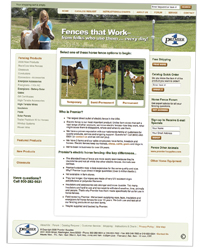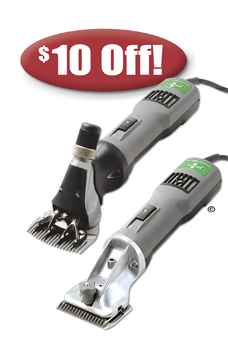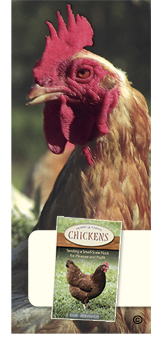Message from the Owner
The Era of Cheap "Stuff" is OverIt's no secret that prices for most items (fuel, feed, supplies, equipment) that we all purchase to care for our families, livestock and land have increased sharply. But:
A. Fuel and electricity B. Feed (grain, hay) C. Supplies and Equipment The grim truth is that the price increases are not over. Another grim truth is that the low prices of the past 10 years are not coming back. Why?
For the USA it's adapt or fall behind. by Stan Potratz What's New
Now Live! - Premier's NEW Horse Fence Websitewww.horsefencesthatwork.com
You can still visit www.premier1supplies.com for all species and products. Special Price from Premier!
$10 off! Clippers, Shears and Packages(Remember: FREE SHIPPING on qualified website orders) Purchase a clipper, shear or a package (see below) and receive $10 off! This offer cannot be combined with any other claim codes or offers. However, free shipping on qualified website orders still applies. Order soon! This promotion expires on July 15, 2008.Premier's Shear & ClipperQuiet High performance motor Cooler Easy to hold & maneuver Unique 3 year warranty! Promo Codes: For phone orders: NEWSB
Poultry
Floor Space Requirements for ChickensThe minimum amount of floor space needed per chicken depends on several factors, including bird type, the presence of indoor roosts and the size of outdoor run. Free-range chickens and chickens with adequate outdoor runs and indoor roosts:
Confined chickens without access to outdoor runs:
Excerpt from Sue Weaver, Chickens (Hobby Farms Series). Item #981024 (Laguna Hills, CA: BowTie Press). Reprinted with the permission of the publisher. New Poultry Products from Premier, visit www.premier1supplies.com Premier VIPExternal Parasites (Lice, Keds and Mites)External parasites can affect sheep at any time of year. Transmission occurs during times when sheep are held in close confinement and have long wool, e.g. winter in the Midwest. Spring or summer treatment gives us an opportunity to control external parasites as ewes are shorn and in many cases sheep have not been released to pasture. External parasites that affect sheep are classified in three general groups: lice, keds and mites. There are many species of lice that can infect sheep. Lice species are divided into two general classifications. The group that feeds off of dead skin cells is commonly called chewing lice. The other group feeds off of body fluid and is called suckling lice. The importance of the difference is in control. Ivermectin is only effective if the species of lice feed off of body fluid. Treatment of chewing lice requires topical application of insecticides. Lice spend the majority of their life on the sheep. They can survive in the environment for only short periods of time. The ability to survive off the animal contributes to their rapid spread among penmates. Lice eggs (nits) are resistant to insecticides, therefore using a prolonged activity pour-on like Delice or Ultraboss gives a higher treatment success. If you are treating with a short-acting insecticide treatment should be repeated in one to two weeks. Sheep with wool loss should be inspected to see if there is evidence of nits. They are small (size of a pin head) and "glued" to the wool fibers. If you are unsure your Veterinarian can confirm the presence of nits by examining the affected wool under a low power microscope or magnifying glass. Adult lice are difficult to see with the naked eye but can be visualized with a magnifying glass as well. Keds consist of only one species of insects. Many shepherds refer to keds as ticks, although technically they or not ticks as they have only 6 legs. They are actually a wingless fly. Keds spend all of their life on sheep. The male and female both remove blood from the sheep and cause itching, scratching, wool tags on fences, hide damage and poor fleece quality. Keds are only spread by direct contact. They are often seen at shearing as they are large enough to be seen with the naked eye. Treatment for keds is easy. Pouring with Delice pour on after shearing is highly effective. Since the keds feed off of blood, injectable Ivermectin is also effective, but more costly. Keds are unique in that the female ked is larviparous. This means that the female ked does not lay eggs, instead the eggs and larvae mature inside the female ked and she lays pupae that then develop into adults. The pupae stage is resistant to pour-on and Ivermectin. Because most of the life cycle is sensitive to treatment one treatment will significantly drop the population. Two treatments 2 weeks apart are necessary for total eradication of keds. Mites are different than lice or keds in that they burrow below the skin surface or in the wool follicles whereas lice and keds inhabit the surface of the skin and wool. As mites burrow they cause extensive tissue irritation causing the sheep to itch frequently. This results in a scab or crusty lesions. Affected are often wool-less areas on the head or feet. If the lesion is in a wooled area the wool will fall out and the skin will be reddened or covered with a scab. Mite infections can be confirmed by having your Veterinarian do a skin scraping of affected areas. The skin scraping is examined under a microscope and if mites are seen they can be identified to the species which may help with control. Because mites survive off of body fluids injectable Ivermectin is very effective. Repeated administration 2 weeks apart may be necessary for problem cases. Topical amitraz, available in a dip call tactic is also very effective. Treatment for ectoparasite control (lice, keds or mites) is always more effective and easier on shorn sheep. Many producers find that immediately after shearing is labor-efficient and in the upper Midwest this coincides with the time of the year that ectoparasites are a problem. If treatment of heavy wooled sheep is necessary be sure to part the wool so that the pour-on contacts the skin. By J. Larry Goelz, DVM, Pipestone Veterinary Clinic, Pipestone, MN 56164, (507) 825-4211 Premier Employee Spotlight
Cheyenne MillerOur photographer, our resident "ghost hunter" and a new mom at Premier. Cheyenne Miller is our featured employee. From Fairfield, Iowa, she says "photography allows me to use both sides of my brain in unison-the artistic side and the technical side. Photo work at Premier is challenging. Every photo shoot is unique. I can immediately see the results of my work." The best part of her two years at Premier "have been the people," she says. "They are very down to earth and personable. It really is like a family." Speaking of family, Cheyenne and her husband Andy are proud parents of their first child, a daughter, Carys Elaine, born May, 11. Also sharing their house is a very fat cat-Buddy. In her spare time she is the co-founder of a paranormal investigative group named SPOOKS. Yes, she hunts ghosts! Cheyenne records, photographs and video tapes anything out of the ordinary. She also enjoys reading military books (honestly she does) and free-lance photography. For whatever life throws at her, she says that "Fortune Favors the Bold." Her dad told that to her on her wedding day. She says, "so far, so true." RecipeMacaroni SaladIngredients: 1 lb macaroni, cooked & drained Mix together macaroni, green pepper, carrots, onion, salt and pepper. In a separate bowl combine condensed milk, sugar, vinegar and mayonnaise. Pour over pasta. Mix and store in a large container and chill over night. from Sara McArtor, Premier employee |






